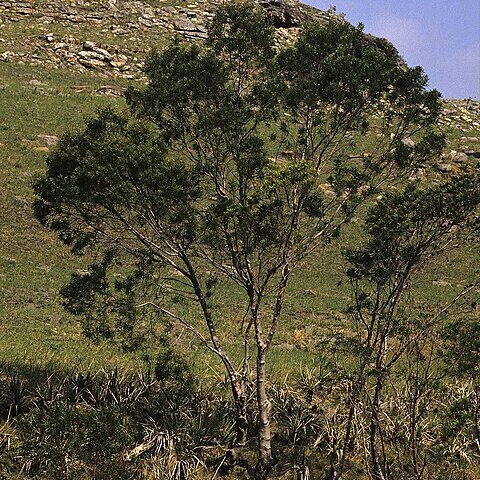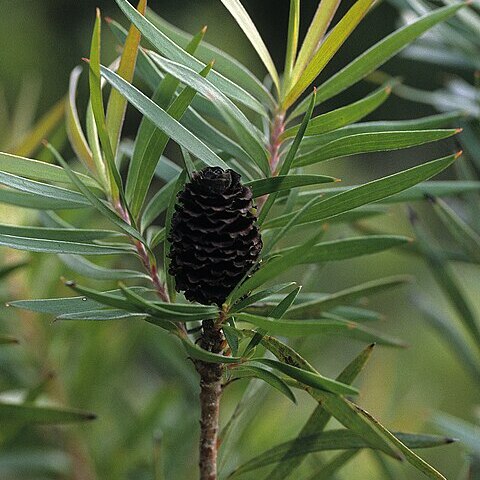Evergreen, dioecious shrub or tree up to 6 m tall, with a single trunk up to 200 mm diam., without a persistent subterranean rootstock; old plants often with the trunk oblique owing to floods; bark pale grey or grey-brown, smooth, with minute pustules. Branchlets erect or spreading, arising from immediately below the previous year's inflorescence, numerous and slender in male, slightly fewer and thicker in female, bright pink to red and adpressed puberulent when young, appearing silvery adpressed-puberulent in dried material, becoming glabrescent, brownish or greyish with age. Leaves subpetiolate, spreading; lamina linear, somewhat falcate, in male plants 35-50(-60) x (2.5-)3.0-4.0 mm. in female plants 50-70 x 3-4 mm, at first sparsely silvery pubescent (denser on abaxial surface) and ciliate, soon becoming glabrous except at the extreme base, coriaceous, dark green and shiny; apex mucronate, mucro subulate, red, 2-4 mm long, broadly and shallowly grooved above; base gradually tapering, petiolar portion pink to red, c. 2 mm long, twisted, usually densely adpressed pubescent when mature. Involucral leaves absent. Male inflorescences capitate, more or less globose, c. 10 mm diam., solitary, terminal, conical in bud, unscented; peduncle 3-5 mm long, densely silvery pubescent, usually with c. 3 small transitional leaves. Basal bracts c. 2 x 3 mm, about 8 in number, linear, becoming broadly elliptic and acute towards the head, basal portion thick and fleshy, ciliate and densely pubescent abaxially. Floral bracts c. 2 x 1.5 mm, obtuse or acute, ciliate and densely pubescent below. Buds c. 4 mm long, pubescent; apex pale cream, swollen and subquadrangular. Perianth divided into 4 parts above; segments coherent below, cream-coloured. Perianth tube c. 2 mm long, glabrous. Claws c. 1 mm long, recurved through 90-180° at anthesis, densely pubescent outside. Limbs c. 1.5 mm long, slightly concave, densely pubescent outside, hooked at the apex. Anthers c. 1 mm long, spathulate, connective occasionally brown. Stigma abortive, c. 1 mm long, clavate, acting as a pollen presenter. Style c. 3 mm long, slightly narrowed above, weakly pubescent below. Hypogynous scales c. 1.5 mm long, acicular; nectar seen at throat of Perianth tube. Receptacle c. 5.5 x 2 mm, narrowly ellipsoid. Female inflorescences 12-15 x 8-9 mm, ellipsoid, solitary, terminal on scattered branchlets, less numerous than on male plants, the florets arranged in 5-8 ascending spiral rows with about 13-20 cm each, unscented. Basal bracts as in male. Floral bracts c. 2 x 5 mm, broadly elliptic, obtuse; abaxial surface densely silvery pubescent towards middle and base; margins ciliate. Buds c. 3 mm long, narrowing slightly towards apex, densely pubescent; stigma concealed or exposed in buds lacking the anterior limb. Perianth tetramerous, cream-coloured; segments coherent below. Perianth tube 2.0-2.5 mm long, transversely compressed, densely pubescent becoming almost glabrous towards the base. Claws c. 1 mm long, posterior one more or less erect, two lateral ones usually recurved through c. 90°, anterior one (if present) through c. 180°, outer surface densely pubescent. Limbs c. 0.75 mm long, outer surface densely pubescent, anterior one glabrous and the first to recurve at anthesis, occasionally hairy or absent. Stamin-odes 0.5 mm long, vestigial; anterior staminode absent. Ovary c. 1 mm long, ovoid, densely pubescent. Style 1.75-2.00 mm long, glabrous. Stigma up to 1.25 mm long, lateral, oval or circular, not cleft. Hypogynous scales as in male; nectar in minute quantities occasionally seen. Receptacle c. 8 x 2 mm, narrowly ellipsoid. Fruiting head a cone, 25-35 x 15-20 mm, outer surface glabrous, with bracts densely pubescent abaxially, broad, laterally lobed and coherent towards base. Fruit a nut, 4-5 x (2.5-)3.0-3.5(-4.0) mm, obovate in outline, dull black, pitted, very sparsely pubescent, perimeter narrowly (0.1-0.2 mm) winged or ridged, adaxial surface convex, with a longitudinal median ridge, abaxial surface more or less flat, apex occasionally slightly emarginate, basal scar surrounded by a few short hairs.
More
Tree or shrub, 3-6 m high, dioecious. Leaves narrowly oblong, 35-60 x 2.5-4.0 mm in male plants, 50-70 x 3-4 mm in female ones, coriaceous, silver-hairy, hairless when mature, slightly sickle-shaped, apex a fine red point; involucral leaves absent. Male flowers in terminal, globose capitula, 10 mm in diam., covered with silver hairs. Involucral bracts 8, linear, inconspicuous with soft hairs on outer surface. Female flowers in terminal, ellipsoid capitula, 12-15 x 8-9 mm; perianth 3.0-3.5 mm long. Mature capitulum a globose cone, 25-35 x 15-20 mm, hairless at tip, dense hairs below. Flowering time Sept.-Dec. Fruit sharply edged, released after 12 months.



